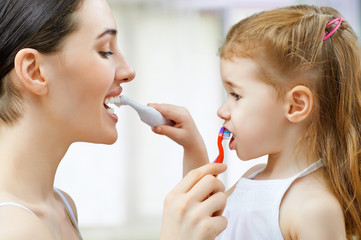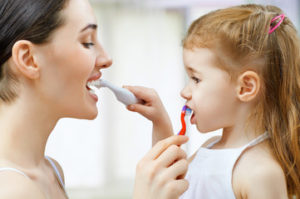by Tracie Dahl, OTR/L
Kids Place Central Pediatric Occupational Therapist
Teeth begin to appear as early as six months old and should be brushed twice a day as soon as they appear, according to the American Dental Association. But brushing a child’s teeth, especially a young child, is challenging (and stressful), especially when there is crying, screaming, or pushing the toothbrush or parent away.
A child may resist tooth brushing due to their fear of an unfamiliar task, sensitivity to new textures in their mouth, or a general dislike of the taste. Regardless of the reason your child is not tolerating tooth brushing, here are simple strategies to better their experience:
Temperature – consider the water temperature.
Try to avoid extremes (very cold or hot) and use neutral or lukewarm water.
Flavor – try a different type of toothpaste.
Mint is often a strong flavor for children to handle. Several companies sell child friendly flavors such as fruit and bubble gum. If your child still doesn’t like these, try flavorless toothpaste. It may be available directly from your dentist or purchased online. For children who are just starting to tolerate tooth brushing, you can get them used to the sensation of brushing without the flavor of toothpaste and introduce toothpaste once they are more comfortable with the task.
Toothbrush type – ensure your child is using an appropriate toothbrush.
Children’s toothbrushes typically have soft bristles and are smaller in size to fit in their smaller mouth. Children may be motivated to use a toothbrush that has a favorite character or animal. They also may be excited by picking out their own toothbrush at the store. If your child is older, consider an electric toothbrush. They may enjoy the vibration and different sensations from an electric toothbrush, but make sure to consult with your dentist since these are typically not recommended for children under 3.
Education – children might not understand what is supposed to happen.
Try modeling the activity for them and if comfortable, let them help you brush your teeth by holding and moving the toothbrush, just as you would help them. Have them pretend brushing the teeth of a toy, stuffed animal, or doll. Take turns brushing the toy’s teeth and the child’s teeth. For example, first brush the toy’s teeth for 10 seconds, then the child’s teeth for 10 seconds, continuing with this back and forth until the child’s mouth is fully brushed. Increase the time spent brushing as it’s tolerated.
Time – children may tolerate toothbrushing better when the end is in sight!
Use a visual timer such as a sand timer or phone app that shows them how long they need to brush. Start with a shorter amount of time, and increase the length each trial until they can brush for the recommended 2 minutes. Many fun songs are available online to encourage brushing for the full 2 minutes. Have your child brush to keep the song or video going; if they stop brushing, stop the song and restart when they restart brushing.
If your child continues to be very resistant to toothbrushing after trying these strategies, it may be beneficial to consult with an occupational therapist to determine why the child won’t participate and learn other techniques to increase success. Make sure to discuss any questions about appropriate toothbrushes, toothpaste, or changes in oral health with your child’s dentist.
Another helpful resource on children’s oral health: https://www.mouthhealthy.org/en/babies-and-kids








